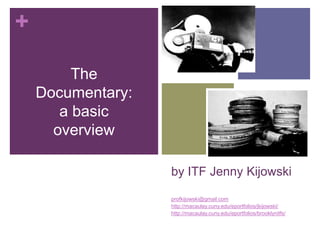
Documentary
- 1. + The Documentary: a basic overview by ITF Jenny Kijowski profkijowski@gmail.com http://macaulay.cuny.edu/eportfolios/jkijowski/ http://macaulay.cuny.edu/eportfolios/brooklynitfs/
- 2. + documentary Fact-based film that depicts actual events and persons. Documentaries can deal with scientific or educational topics, can be a form of journalism or social commentary, or can be a conduit of propaganda or personal experience.(from the Concise Dictionary at http://www.merriam-webster.com/dictionary/documentary)
- 3. + The 3 Stages 1) Pre-production: planning your film 2) Production: shooting your footage 3) Post-production: putting it all together
- 4. + Pre-production: the vision What story do you want to tell? Do some research to hone in on the particular angle you want to take. Fact check, find historical documents, download images for use in your film (remember to document your citations!) Watch some documentaries—get inspired! Feed Me a Story by local filmmaker Teresa Loong The National Parks: America’s Best Idea by Ken Burns (extended preview on PBS) Raising Adam Lanza by PBS’ Frontline series What are your limitations and constraints? Do you have the resources you need? You can rent equipment from Macaulay: http://macaulay.cuny.edu/community/doit/av-request-form/
- 5. + Pre-production: who, what, where, when & how Who are the main players? Set up interviews and get permissions Have your questions ready and practice them on people. What are the critical shots? Where are the main places? Scout your location(s) if possible. When are you going to get it done? What are your time constraints? Make a schedule. How are you going to get it done? Assign group members to particular tasks, such as director, primary videographer, interviewer, project manager, etc.
- 6. + Pre-production: Create a Storyboard brainstorm ideas, map out the flow of your story Image from https://coursework.stanford.edu/access/content/group/Multimedia/storyboards/kenneth_chan_storyboard001.png
- 7. + Production and…action! Shooting video Take more footage than you think you will need Don’t forget the value of “establishing shots” to situate your viewer What details might be useful? Conducting interviews Have your prepared questions, but don’t be afraid to ad lib Try to conduct your interviews in quiet places with natural lighting Go for consistency Taking photographs Still images can add dimension and texture Be mindful of production value Unless skillfully used, footage taken in poorly lit, noisy or busy environments can detract from, rather than add to, your documentary
- 8. + Post-production: revisit your initial vision Review/revise your storyboard Does your footage conform to the story you initially set out to tell, or is there a different story that emerges? Please be respectful of other people’s stories. Does your footage have a focus? Considerations of audience Who is your intended audience? Who else might see it? How will your film be interpreted? What are the limitations on your control over reception?
- 9. + Post-production: the rough cut Edit your footage in iMovie Use your storyboard as a guide Identify the most relevant clips and quotes Edit your footage down to your desired time limit Don’t use effects yet Focus focus focus!
- 10. + Post-production: the final cut Audio Write and record your voiceover script(s) add music & sound effects Ensure that your audio levels are equalized throughout the film Visual Use transitions to help ensure smooth flow between clips &/or images Add captions/text where necessary or desired Avoid overusing special effects Advanced iMovie tutorial http://macaulay.cuny.edu/eportfolios/alterman13/2013/03/31/advanced- imovie-presentation/
- 11. + Additional Tips Transcribe your interviews Make the text available for download Don’t create your film in a bubble Have an outside set of eyes to critique your documentary Copyright Everything belongs to somebody. There are rules to using music, images and videos you find online. See my tips for preventing copyright infringement at http://macaulay.cuny.edu/eportfolios/jkijowski/resources/using-music-images- videos/. Citations Professor Alterman has stated that all factual material must be fully sourced in footnote form, according to either Chicago Manual of Style or the Modern Language Association (MLA) guidelines.